First Look: AM2 DDR2 vs. 939 DDR Performance
by Wesley Fink on April 17, 2006 12:05 AM EST- Posted in
- CPUs
Comparing Memory Performance
When comparing many results, it is sometimes easier to see relative positioning of test results visually in a graph instead of interpreting numbers in a table. The full range of memory speeds were compared, first in Memory Benchmarks and Super Pi Calculation Performance
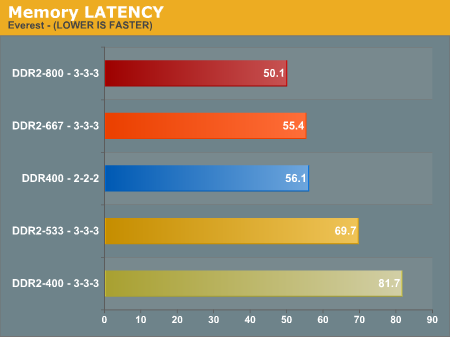
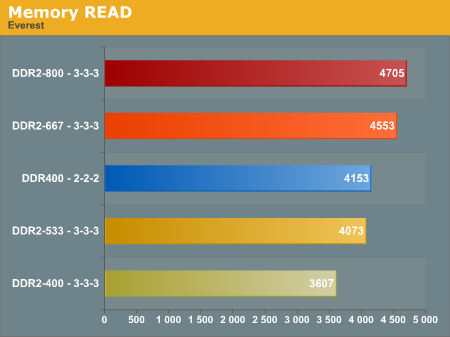
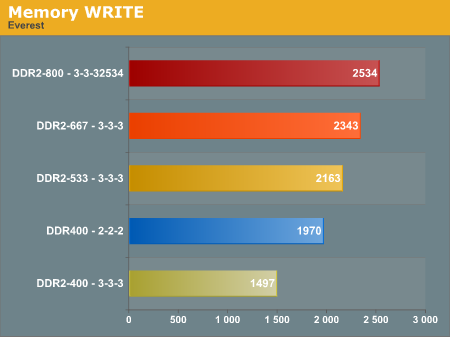
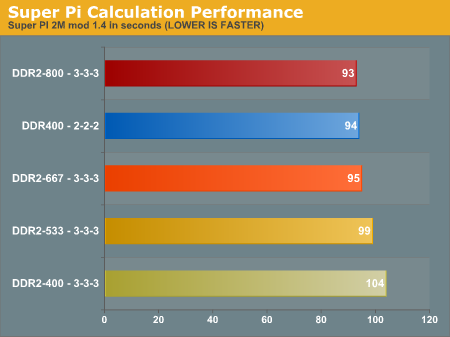
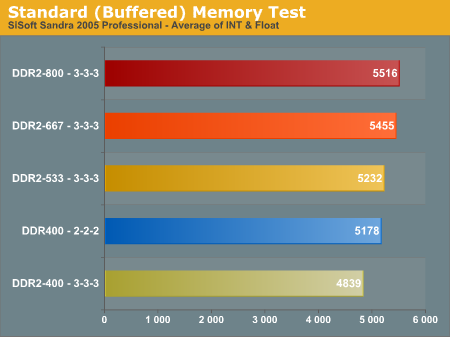

Synthetic Memory benchmarks show DDR400 latency and bandwidth roughly comparable to DDR2-533 3-3-3 performance in our tests. DDR2-667 3-3-3 is a bit higher, with best performance on this 4th spin of AM2 at DDR2-800 3-3-3.
The AM2 memory controller is finally meeting the promise of DDR2 with a dedicated on-processor memory controller. Latency is faster than DDR on AMD and quite a bit faster than latency on the Intel DDR2 memory controller in the motherboard chipset. Efficiency still lags considerably with a top Everest Read+Write Bandwidth of 7.2GB/s compared to a theoretical max of 12.8. This compares to the DDR400 Everest bandwidth that is close to the theoretical maximum of 6.4. As already said, this opens the door for further improvements in DDR2 memory performance as AM2 matures and shrinks to 65nm, more cores, and larger caches.
When comparing many results, it is sometimes easier to see relative positioning of test results visually in a graph instead of interpreting numbers in a table. The full range of memory speeds were compared, first in Memory Benchmarks and Super Pi Calculation Performance






Synthetic Memory benchmarks show DDR400 latency and bandwidth roughly comparable to DDR2-533 3-3-3 performance in our tests. DDR2-667 3-3-3 is a bit higher, with best performance on this 4th spin of AM2 at DDR2-800 3-3-3.
The AM2 memory controller is finally meeting the promise of DDR2 with a dedicated on-processor memory controller. Latency is faster than DDR on AMD and quite a bit faster than latency on the Intel DDR2 memory controller in the motherboard chipset. Efficiency still lags considerably with a top Everest Read+Write Bandwidth of 7.2GB/s compared to a theoretical max of 12.8. This compares to the DDR400 Everest bandwidth that is close to the theoretical maximum of 6.4. As already said, this opens the door for further improvements in DDR2 memory performance as AM2 matures and shrinks to 65nm, more cores, and larger caches.










37 Comments
View All Comments
peternelson - Saturday, April 15, 2006 - link
I notice all your tests were performed in 32 bit mode.
This cpu can handle 64 bit instructions.
While 64 bit registers (and more of them) allows faster data manipulations, that advantage is traditionally offset by the need for bigger wordsize of instructions.
So if the memory reading of the instructions is more memory-hungry that could be more use for this extra memory bandwidth.
Therefore I suspect IN 64 BIT MODE, there could be more advantage on a fast DDR2 than on a bandwidth-limited DDR system.
How to test this? Well you could run some 64 bit Windows and BENCHMARK FAR CRY in 64 bits version as it is available as 32 and 64 bit.
See if running in 64 bit with this new ddr2 memory negates the disadvantage of limited bandwidth for instruction feeding?
If so this would be increasingly an advantage in future as more people move to 64 bit OS, including at Vista-time.
smitty3268 - Saturday, April 15, 2006 - link
The larger instruction size is barely an issue. The real difference is that all pointers are doubles in size from 32 to 64 bits. This can lead to a significantly lower number of variables stored on the cache, which can lead to increased bandwidth usage.AnandThenMan - Saturday, April 15, 2006 - link
I agree with what you are saying. In 64 bit mode, that A64 *should* benefit from the increased DDR bandwidth.The problem is, the 64 bit version of Farcry was basically a scam and offered no performance or visual increases solely because it was a 64 bit optimized game. If I remember correctly, the extra visual effects in the 64 bit version were basicially enabled if run in 64 bit mode, but had little or nothing to do with actually being optimized for the A64 in 64 bit mode.
peternelson - Saturday, April 15, 2006 - link
I see your point too.
Yes some additional features could have been done on 32 bit version but were restricted to 64 bit platforms. But surely the compiled binary was actually a 64 bit binary even if not optimised much? In which case it would still be interesting to compare.
32 bit DDR versus 64 bit DDR and versus 32 bit DDR2 and versus 64 bit DDR2.
My hypothesis is that the speedup (even if small) from using the 64 bit binary over the 32 will be greater on AM2 DDR2 than the same test on 939 DDR.
I agree that Far Cry was not the best example, but you may know of other good benchmarks or games which are tuned for this.
eg the same four tests of PRIME95 (www.mersenneforum.org) which is available in 32 and 64 bit. The Trial factoring test benchmark shows a good speedup in 64 over 32 bit operations. But then that doesn't use main memory much as it is highly optimised to work inside the L1/L2 cache. There must be other suitable tests though to compare 32 and 64 bit on some memory intensive task with binaries optimised for each architecture.
IntelUser2000 - Saturday, April 15, 2006 - link
Right, the hypothesis for higher clock speed giving better increases were similar, however it gave less increases.
Wesley, there is another typo. On this page: http://www.anandtech.com/cpuchipsets/showdoc.aspx?...">http://www.anandtech.com/cpuchipsets/showdoc.aspx?...
DDR400 to DDR2-800 performance increase in CoD2 is said to be 10.6%. That is not correct. DDR400 to DDR2-533 is 10.6%, but DDR400 to DDR2-800 is only 6.7%. Check your calculation numbers please.
Wesley Fink - Saturday, April 15, 2006 - link
The calculation has been corrected. Thank you for catching this and bringing it to our attention.peternelson - Saturday, April 15, 2006 - link
You should not claim AMD's on-processor memory controller is UNIQUE".Unique means nobody else does it and it is a unique feature of AMD.
THAT is incorrect.
Although Intel don't do it, there are other chips that have on-chip DDR or DDR2 controllers including Clearspeed. I can even put a ddr or ddr2 controller (or several) into my own chip designs in a Xilinx FPGA because Xilinx license the design free for use in their chips.
Griswold - Saturday, April 15, 2006 - link
Pretty unique in the x86 world, isnt it?peternelson - Saturday, April 15, 2006 - link
No, actually it isn't. That was precisely my point.
Transmeta Efficeon and VIA C7 can both have on die memory controllers too.
They run x86 instructions quite happily.
Don't get me wrong, it's a good idea, it's just not UNIQUE any more.
Wesley Fink - Saturday, April 15, 2006 - link
Transmeta and the VIA C7 aren't really AM2 and Conroe competitors in most situations. However, I can conceive some applications where they might be. To be more precise I will try to use another word to describe the on-processor memory controller in the future.Do you work for VIA or Transmeta?